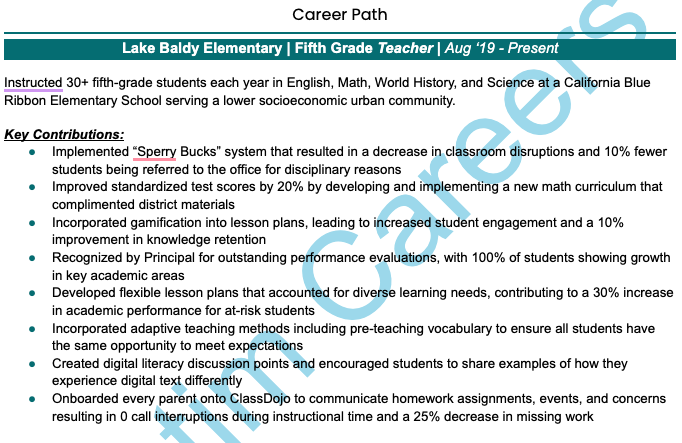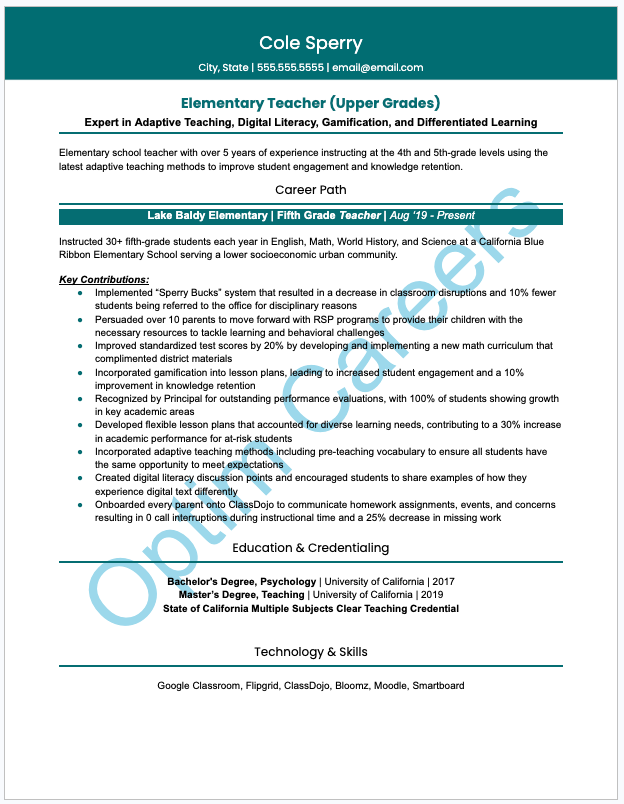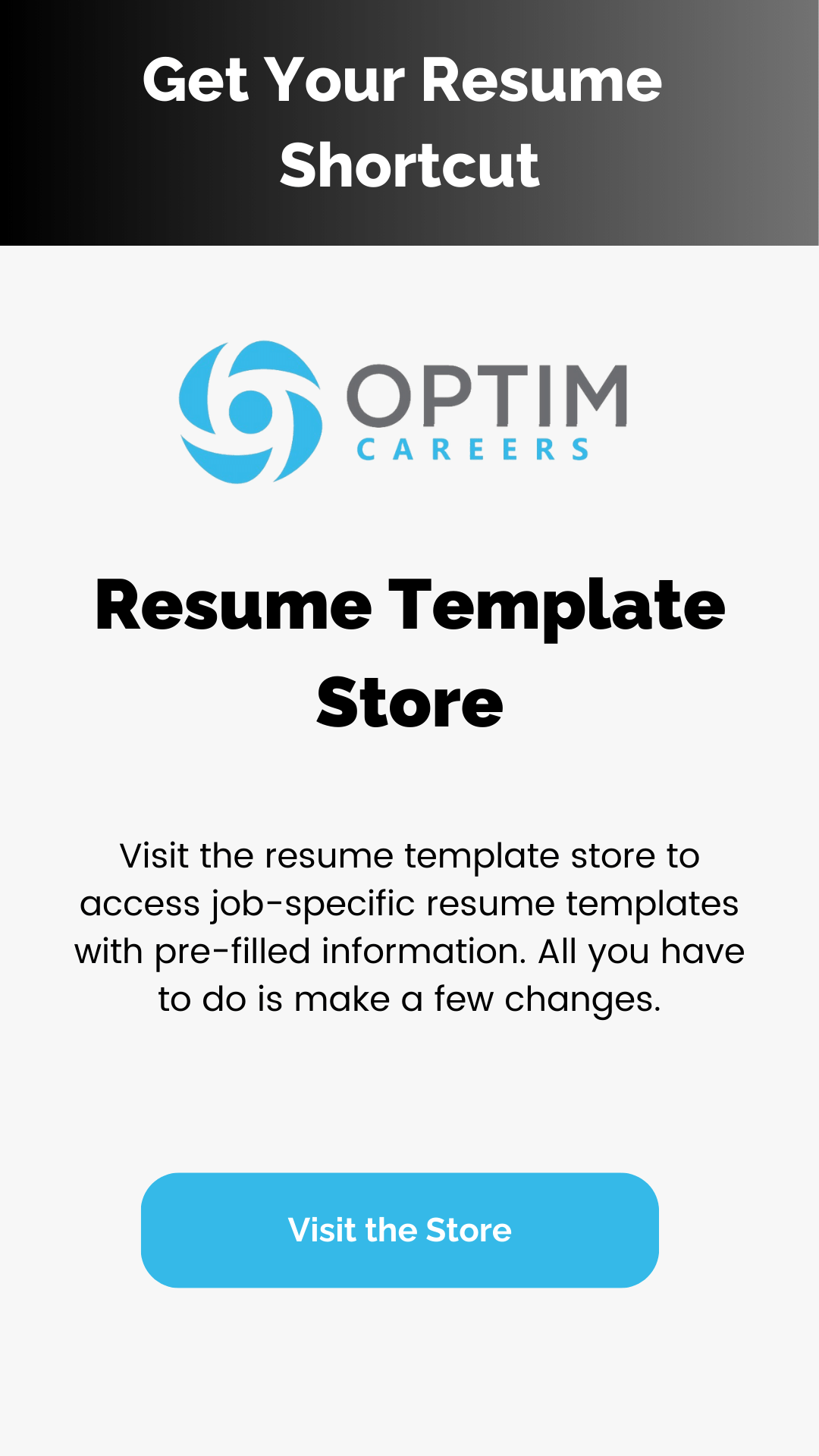Teacher Resume
Many websites treat teacher resumes the same as all others and that’s simply bad form. I was a teacher; my wife is a teacher still. I can tell you that there are nuances to teaching resumes that are different from industry.
Many AI tools and websites that take a one-size-fits-all approach are misleading you. That’s not to say that all resume AI tools are bad and you shouldn’t use them, but be careful where you get your advice. In fact, I’m going to use an AI program to write a teacher resume with you in this guide.
Many resume builders and guides treat teacher resumes like all the rest by suggesting loading them with metrics. I think that’s a bad idea. Why? Because teachers don’t track metrics in the way that most guides suggest.
You’re not tracking how many kids ask to use the bathroom during instructional time each day and analyzing which days are lower than others. If you’ve ever been a teacher, you know this would be a stupid idea. You don’t have time for that stuff.
So discard what you’ve read in the past and use this guide to write the teacher resume that shows your qualifications the right way.
In this guide, we’re going to cover writing a resume for K-12 jobs. Whether you are just starting your teaching career or you’ve been at it for some time, this guide will work for you.
We’ll cover the following:
Teacher Resume Skills and Experiences You Should Be Talking About
Resume Sections to Include in Your Teaching Resume
Formatting Tips and Things You Need to Know
How to Use AI to Write Job Experience in Under 2 Minutes
Some Teacher Resume Examples
And a Few Other Questions You May Be Asking
Let’s go!
Teacher Resume Skills
Many resume guides give you a list of skills to list in a bullet point fashion, under a skills heading, without context. I think that is a poor use of space on your resume. Rather than do that, I want to dive deeper into the skills organizations ask for in their teachers and then show you how to craft experience statements that show the skill, rather than tell it with no context.
If you can take these skills and show them in action with your experiences, you’ll be lightyears ahead of your peers when applying for teaching jobs. Here are some of the teaching skills for resumes that you should be writing about.
Classroom Management
Ex. Implemented “Sperry Bucks” system that resulted in a decrease in classroom disruptions and 10% fewer students being referred to the office for disciplinary reasons.
Curriculum Development
Ex. Improved standardized test scores by 20% by developing and implementing a new math curriculum that complimented district materials.
Lesson Planning
Ex. Incorporated gamification into lesson plans, leading to increased student engagement and a 10% improvement in knowledge retention measured by testing.
Performance Evaluations
Ex. Recognized by Principal for outstanding performance evaluations, with 100% of students showing growth in key academic areas
Differentiated Instruction
Ex. Developed flexible lesson plans that accounted for diverse learning needs, contributing to a 30% increase in academic performance for at-risk students.
Digital Literacy
Ex. Created digital literacy discussion points and encouraged students to share examples of how they experience digital text differently.
Adaptive Teaching Methods
Ex. Incorporated adaptive teaching methods including pre-teaching vocabulary into lesson plans to ensure all students have the same opportunity to meet expectations.
Communication (Parent-Teacher, Admin-Teacher, Student-Teacher)
Ex. Onboarded every parent onto ClassDojo to communicate homework assignments, events, and concerns resulting in 0 call interruptions during instructional time and a 25% decrease in missing assignments.
Conflict Resolution
Ex. Collaborated with school counselor to address challenging student behaviors and develop personalized strategies to de-escalate conflict among students with behavior patterns.
Time Management
Ex. Collaborated with fourth-grade team to share and disseminate lesson plan materials resulting in a 20% reduction in lesson planning prep time.
If you’re having difficulty creating statements like the ones I’ve used, AI can be a huge help to you. I made all of these with the help of Huntr (the best Resume AI I’ve found so far). And I did it in less than 2 minutes.
Traits to Show in Your Teacher Resume
Objectivity
Patience
Empathy
Staying Calm Under Pressure
Technology Skills for Your Teacher Resume
Google Classroom
Microsoft Teams for Education
Flipgrid
ClassDojo
Bloomz
Moodle
Other Important Things to Include in Your Teacher Resume
Subject Area Expertise
Age Group / Grade Level Expertise
Online/Virtual/Hybrid Teaching Experience
Stem or Steam Instruction
Teacher Resume Sections
Now that we’ve got an idea of what kind of content we should include in our teacher resume, let’s create an outline and discuss where that content should be used - and how!
Header Contact Information
The first thing at the top of your resume should be your name, phone number, email address, city/state, and target job title.
If you’re building your resume in Google Docs or Microsoft Word, you can put this in the header of the document. Or if you’re using a program like Huntr, you can simply click a button and choose from some cool designs like the one below.
Introduction Summary
The next section to include on a great teacher resume is an introduction. This shouldn’t be a recap of the rest of the resume or be loaded with feel-good statements like “passionate about fostering positive learning environments.” I mean what does that even mean?
Instead, ask yourself what kind of teacher problems you want to be known for solving. Are you the teacher who improves test scores? Are you the teacher who reduces distractions and disciplinary actions? Are you the teacher who uses the latest adaptive learning methods? What do you want to be known for? What’s the biggest one facing your school district right now? When an administrator reads it, what will make them think, “This would be a nice addition to our staff?”
Here’s an example teacher summary that I’ve used. Feel free to copy it if it resonates with you.
Elementary school teacher with over 5 years of experience instructing at the 4th and 5th-grade levels using the latest adaptive teaching methods to improve student engagement and knowledge retention.
I can even build it in the Huntr app (in case you’ve been using it like I have to come up with killer bullet point statements and formatting). Here’s what it looks like in one of their templates.
Work Experience Section
I prefer to write a job summary followed by bullet points that show evidence of my qualifications for the job. However, I write job summaries for teaching jobs slightly differently than I do for industry.
The job summary is 1 to 2 lines of text that gives context about things like class size, age group, and subject matter expertise (if you’re teaching upper-level grades). It may look like this:
Instructed 30+ fifth-grade students each year in English, Math, World History, and Science at a California Blue Ribbon Elementary School serving a lower socioeconomic urban community.
Then use bullet points to provide evidence of your qualifications. This structure will make it easier to read your resume because it provides a logical structure to the delivery of information (just like you would do when presenting information in the classroom - logically!).
When listing bullet points, it’s best to start with an action verb + result + how you achieved that result. You don’t have to list them in that order, but make sure all elements are present.
Here is a sample list of relevant bullet points you could use in a teacher resume. I created these in less than 2 minutes using Huntr’s AI.
Here’s what it looks like put all together in my resume template.
Education
After your work experiences, follow with an education section. You can expand this section to also include certificates and licensing as well.
When listing your education include your degree, the school, and the year of completion. I know I don’t normally advise including graduation year in many industry resumes, but in a teaching resume, I always recommend including it.
This is the best place to also list your teaching credentials. List it like this, “State of California Preliminary Multiple Subjects Teaching Credential, June 2023”.
Classroom Technology
The final must-have section on a teacher resume is a list of the classroom technology that you are familiar with. If you’ve used it on your own, in a student teaching program, at a school, and you can navigate a program, list it on your resume. You don’t have to be an expert to list it. You also don’t need to list your proficiency level with stars or other arbitrary ratings.
Here are some common classroom technology systems that you should include on your resume:
Google Classroom
Microsoft Teams for Education
Flipgrid
ClassDojo
Bloomz
Moodle
Other Optional Sections
Depending on the school you may be applying to, the demographics of the school, and your background, you may choose to include some of the following (all could be relevant for a teaching resume).
Languages Spoken and Written
Community Involvement and Volunteer Positions
Extracurriculars (ex. math coach, soccer instructor, etc)
Teaching Association Memberships
Hobbies and Interests
Resume Format for Teachers
If you use one of my templates or the ones provided in an AI resume builder like Huntr, you won’t have to worry about formatting. But in case you’re writing this on your own from scratch or you just want to know, here’s some formatting advice.
First, write the resume in reverse chronological order. That means your job experiences will be laid out starting with your most recent experience and then going back in time to older experiences.
The other options include functional resumes which group experiences together by skill set instead of job where they were performed. The problem with this option is that no one knows if you performed a particular task this year or 20 years ago and it usually lacks context that a reverse chronological resume with a job summary provides.
Finally, there is a hybrid resume that combines elements of the two, but I rarely use this and only in very unique circumstances. Chances are you won’t need to do this.
Other Formatting Tips
Use plenty of white space. If you hit someone with a wall of text, there’s a good chance they’ll stop reading it because it requires too many brain calories to process the information. Make it easy to read.
Use font pairing or stick with one font. You can find all about font pairing in my Definitive Guide to Resume Writing.
Keep your margins to one inch to maintain white space, never any smaller than .5 inches.
You can also pair font sizes. I like to use a 10pt font for body text and a 12pt font for headings.
Should I Tailor My Teaching Resume
I think tailoring your resume to each job description is a huge waste of time. There just isn’t that much differentiation if you have a good targeting plan.
For example, if you’re targeting middle school teaching jobs, one resume should capture everything you need. You don’t need to tailor it.
If you’re going to tailor a teaching resume it should be tailored to grade level. Teaching upper grades in elementary school is different from teaching lower grades, and so it makes sense to tailor it in that regard. But you don’t have to tailor it to every job.
How Long Should a Teacher Resume Be
I hate this question because there are so many factors that can impact how long your resume will be. It’s not about length, but quality and relevance of content. How much
material does the administrator need to determine they should interview you? That’s the question at hand.
If you’re a new graduate with some student teaching under your belt, your resume may be one page, but it could be longer. It probably shouldn’t be over two pages.
For most tenured teachers with multiple jobs, your resume will most likely be two pages, some even three pages in length. I don’t recommend exceeding three pages for K-12 jobs.
As you read your resume, ask yourself these questions.
Is everything in here relevant to the reader and do they need it all to make a decision?
Is everything you’ve written concise and without fluff (adjectives and unnecessary words/language)?
Have I avoided writing anything that distracts the reader from my primary qualifications?
If you answered yes to all three questions, your resume length is probably fine. If not, fix it and it will shorten your resume.
Teacher Resume Examples
Elementary Teacher Resume
New Teacher Resume
Teacher Resume Template
If you want to access editable versions of the two template examples, you can do so at the resume store. I wrote both of these teacher resume examples in less than 20 minutes using the Huntr AI to prompt bullet points for me and customizing it using the two template designs I created above.
Access the teacher resume template here.
P.S. You can also use Huntr to write a great cover letter!
Recommended Reading
58 Communication Skills Synonyms for Your Resume
Cole Sperry has been a recruiter and resume writer since 2015, working with tens of thousands of job seekers, and hundreds of employers. Today Cole runs a boutique advisory firm consulting with dozens of recruiting firms and is the Managing Editor at OptimCareers.com.




















The pattern is as predictable as champagne on New Year's Eve, and often about as short-lived.